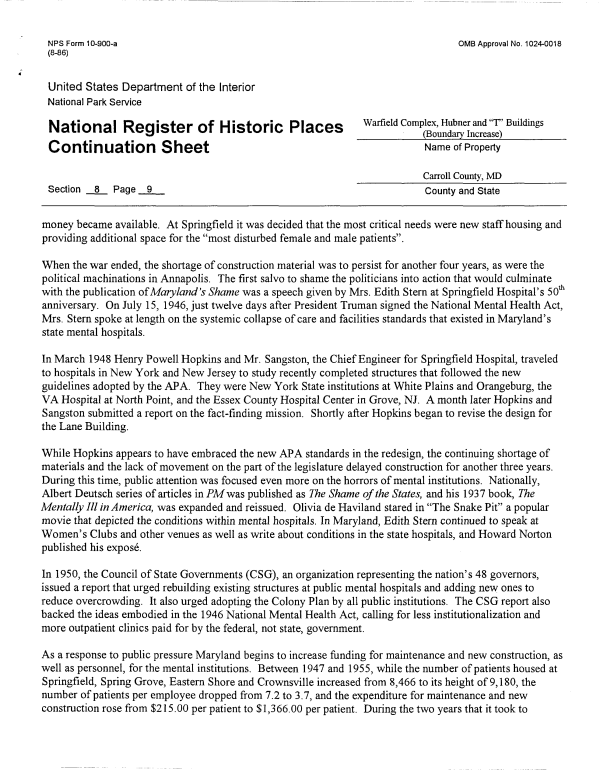 |
||||
|
DEPARTMENT OF HOUSING AND COMMUNITY DEVELOPMENT, MARYLAND HISTORICAL TRUST (Historic Sites Survey) var.d. MSA SE16-7 Image No: se16-7-0322 Enlarge and print image (78K) |
 |
||||
|
DEPARTMENT OF HOUSING AND COMMUNITY DEVELOPMENT, MARYLAND HISTORICAL TRUST (Historic Sites Survey) var.d. MSA SE16-7 Image No: se16-7-0322 Enlarge and print image (78K) |
| NFS Form 10-900-a OMB Approval No. 1024-0018 (8-86) United States Department of the Interior National Park Service National Register of Historic Places WarfieldCompSSeSeasI)BuMngs Continuation Sheet Name of Property Carroll County, MD Section 8 Page _9_ County and State money became available. At Springfield it was decided that the most critical needs were new staff housing and providing additional space for the "most disturbed female and male patients". When the war ended, the shortage of construction material was to persist for another four years, as were the political machinations in Annapolis. The first salvo to shame the politicians into action that would culminate with the publication of Maryland's Shame was a speech given by Mrs. Edith Stern at Springfield Hospital's 50th anniversary. On July 15, 1946, just twelve days after President Truman signed the National Mental Health Act, Mrs. Stern spoke at length on the systemic collapse of care and facilities standards that existed in Maryland's state mental hospitals. In March 1948 Henry Powell Hopkins and Mr. Sangston, the Chief Engineer for Springfield Hospital, traveled to hospitals in New York and New Jersey to study recently completed structures that followed the new guidelines adopted by the APA. They were New York State institutions at White Plains and Orangeburg, the VA Hospital at North Point, and the Essex County Hospital Center in Grove, NJ. A month later Hopkins and Sangston submitted a report on the fact-finding mission. Shortly after Hopkins began to revise the design for the Lane Building. While Hopkins appears to have embraced the new APA standards in the redesign, the continuing shortage of materials and the lack of movement on the part of the legislature delayed construction for another three years. During this time, public attention was focused even more on the horrors of mental institutions. Nationally, Albert Deutsch series of articles in PMwas published as The Shame of the States, and his 1937 book, The Mentally III in America, was expanded and reissued. Olivia de Haviland stared in "The Snake Pit" a popular movie that depicted the conditions within mental hospitals. In Maryland, Edith Stern continued to speak at Women's Clubs and other venues as well as write about conditions in the state hospitals, and Howard Norton published his expose. In 1950, the Council of State Governments (CSG), an organization representing the nation's 48 governors, issued a report that urged rebuilding existing structures at public mental hospitals and adding new ones to reduce overcrowding. It also urged adopting the Colony Plan by all public institutions. The CSG report also backed the ideas embodied in the 1946 National Mental Health Act, calling for less institutionalization and more outpatient clinics paid for by the federal, not state, government. As a response to public pressure Maryland begins to increase funding for maintenance and new construction, as well as personnel, for the mental institutions. Between 1947 and 1955, while the number of patients housed at Springfield, Spring Grove, Eastern Shore and Crownsville increased from 8,466 to its height of 9,180, the number of patients per employee dropped from 7.2 to 3.7, and the expenditure for maintenance and new construction rose from $215.00 per patient to $1,366.00 per patient. During the two years that it took to |